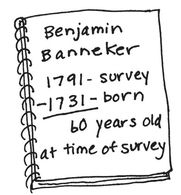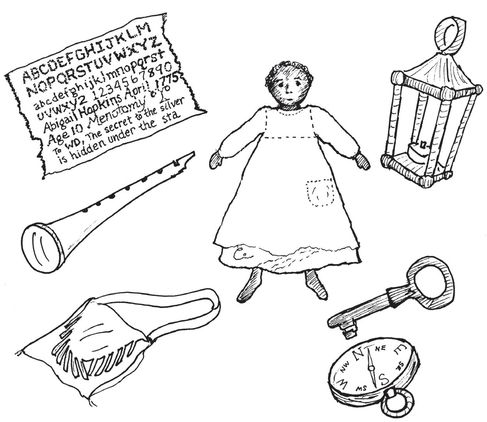Read Meg Mackintosh Solves Seven American History Mysteries Online
Authors: Lucinda Landon
Meg Mackintosh Solves Seven American History Mysteries (7 page)

Peter bought a history book at the museum bookstore that had information about Benjamin Banneker.
“Listen to this, Meg. Benjamin Banneker was an inventor, astronomer, writer, and mathematician. He was born a free black in the British Colony of Maryland in 1731. Banneker taught himself the principles of mathematics and science and became interested in astronomy in 1788, when his neighbor George Ellicott lent him some astronomical instruments.”

“He sounds like a genius!” Meg commented as she scribbled down notes.
“There's more,” Peter continued. “He was one of the surveyors of Washington, D.C.”
What other famous American was a surveyor? Where should they go?
“
George Washington
was a surveyor before he became commander-in-chief of the Revolutionary Army,” Meg declared. “I read that in a biography about him.”
“What do surveyors do?” asked Peter.
“They measure land with instruments and draw pictures of it,” said Gramps. “Let's see if this book tells us anything. Oh, here it is. It says Washington chose the site. He met with some of the surveyors. Banneker helped with the surveying.”


“Let's see, they started to survey the city in 1791. Wow, if Benjamin Banneker was born in 1731, that means he was sixty years old at the time,” Peter figured.
“That's not so old,” Gramps remarked.
“Well, in those days it was. In school I learned the average life expectancy was thirty-something,” added Meg.
“Maybe this is where Robert fits in,” Peter continued. “Maybe Benjamin Banneker brought Robert along to help with the survey. Banneker didn't have any children, but Robert could have been his nephew. He probably had to carry all the equipment.”

“Peter, I think we're getting close to something,” said Meg. “Let's ask that guide if there is an exhibit in the museum that will help us.”
“There
is
an exhibit of the equipment used when the city was surveyed. Let me show you,” said the guide. He took them to the room full of land-measuring devices. “Unfortunately,” the guide informed them, “a piece of a transit used by Washington is missing.”
“I can guess which one,” Peter muttered under his breath.
Which piece is missing?
“The eyepiece!” Peter offered, elbowing Meg. “Maybe we can find it,” he told the guide.
Meg pointed at another eyepiece in the exhibit. “It would look like this, right?” she asked.
“Yes. But I hardly think you'll find it,” the guide said, politely but doubtfully. “It's been missing for over 200 years.”

“We'll see what we can do,” said Peter confidently. Then he whispered to Meg. “Now what are we supposed to do? We don't even know which artifact is important in this history mystery.”
“I was thinking the same thing. Look at your old map, maybe there's another clue. I'll check the artifact list. One of them must have something to do with the missing eyepiece.”
“Oops. I almost forgot,” Gramps said, looking sheepish. “I forgot to give you the last clue.”

“It's a letter from Robert to his Uncle Benjamin!” exclaimed Meg.
“Is it authentic?” the guide gasped. “This is incredible!”
“What does âHouse of Spirits' mean? A funeral parlor?” asked Peter.
“No,” said the guide. “In colonial times spirits meant drinks such as ale or wine. House of Spirits is probably a tavern.”
“Wait a minute, there is an historic tavern where President Washington stayed while the city was being surveyed,” the guide told them. “I'll show you where it is on the map.”
“Listen to this,” Peter said, reading from his book about Benjamin Banneker. “At one point during the survey, President Washington came to visit the site. He stayed in a tavern and met with other surveyors. So it is possible that a meeting between the President and Banneker actually took place.”
“So Benjamin Banneker might have met with George Washington? Then maybe Robert was there too?” Meg said excitedly.
“Thank you for the information,” Peter told the guide. “Don't worry, if we find the eyepiece, we'll give it to the Smithsonian.”

Which mystery artifact do you think fits here?

“The artifact for this mystery has got to be the compass!” Meg said, pulling it out of her knapsack.
“You're right,” Peter agreed. “The compass will show us what's six paces southwest of the House of Spirits. Let's go.”
They raced back to their minivan and before long they arrived at the old tavern.
“It's definitely old,” observed Meg.
Peter read the compass. “The tavern is facing south,” he said.

“Many old buildings were built on a southern exposure to receive the most light and heat from the sun,” Gramps informed them.
“What's this stone post for? asked Peter.
“They would tie their horses to that,” Gramps explained.
“Look at this old sign with the menu,” Meg said. “They certainly had a different way of talking about food. Come on, let's talk to the tavern keeper.”
